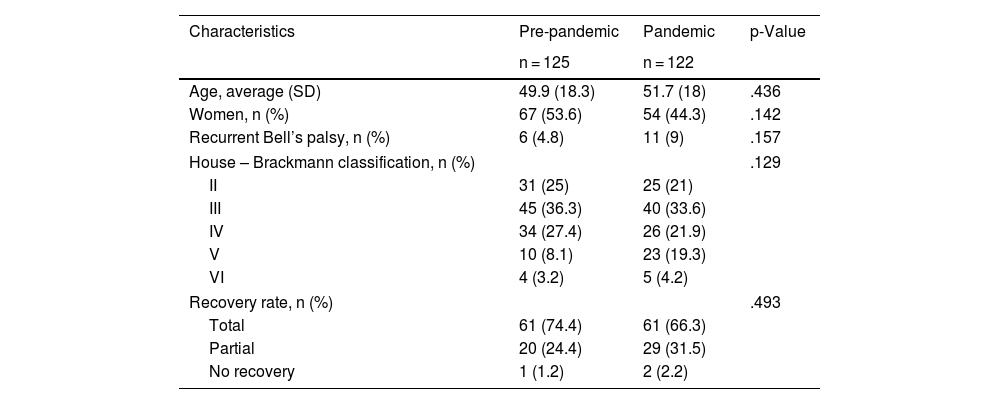During the SARS-CoV-2 pandemic, immune-mediated neurological events have been described in patients vaccinated against the virus or who have overcome the disease. Among these events is Idiopathic peripheral facial palsy or Bell’s palsy.
ObjectivesTo study the incidence of Bell's Palsy in the ENT emergency department of a tertiary hospital in Catalonia during the SARS-CoV-2 pandemic.
MethodsRetrospective historical cohort comparison study of patients diagnosed with Bell's palsy between January 2018 and December 2021. Crude incidence rates were calculated as the total number of events divided by person time at risk per 100.000 person-years. Observed (2020, 2021) and historical (2018, 2019) rates were compared using standardized incidence rates with corresponding 95% confidence intervals.
ResultsOf the total number of ENT emergency department visits from 2018 to 2021 (22.658), there were 247 cases of Bell's palsy. The incidence rate of Bell's palsy in the pre-pandemic group was 12,2 and 10,9 per 100.000 person-years for 2018 and 2019, respectively. The 2020 standardized incidence rate of Bell's palsy was 0,70 [95% CI 0,49–1,01] and 1,25 [95% CI 0,93–1,67] for 2021. No significant differences were evident between the two groups.
ConclusionIn our cohort, no association was found between vaccination or COVID-19 infection and the development of Bell's Palsy.
Durante la pandemia por SARS-CoV-2 se han descrito eventos neurológicos inmunomediados en pacientes vacunados contra el virus o que han superado la enfermedad. Dentro de estos eventos se encuentra la parálisis facial periférica Idiopática o Parálisis de Bell.
ObjetivosEstudiar la incidencia de Parálisis de Bell en el servicio de urgencias de Otorrinolaringología de un hospital terciario de Cataluña durante la pandemia por SARS-CoV-2.
MétodosEstudio retrospectivo de comparación de cohortes históricas de pacientes diagnosticados de Parálisis de Bell entre enero de 2018 y diciembre de 2021. Se calcularon las tasas de incidencia brutas como el número total de eventos dividido por el tiempo de la persona en riesgo por 100.000 personas-año. Las tasas observadas (2020, 2021) e históricas (2018, 2019) se compararon utilizando índices de incidencia estandarizados con sus correspondientes intervalos de confianza del 95%.
ResultadosDel total de consultas al servicio de urgencias de ORL de 2018 a 2021 (22.658), se presentaron 247 casos de Parálisis de Bell. La tasa de incidencia de parálisis de Bell en el grupo pre-pandemia fue de 12,2 y 10,9 por 100.000 personas-año para los años 2018 y 2019, respectivamente. La tasa de incidencia estandarizada de parálisis de Bell del 2020 fue de 0,70 [IC 95% 0,49 –1,01] y de 1,25 (IC 95%: 0,93–1,67) para el 2021. No se evidenciaron diferencias significativas entre los 2 grupos.
ConclusiónEn nuestra cohorte, no se ha encontrado una asociación entre la vacunación o la infección por COVID-19 y el desarrollo de Parálisis de Bell.









